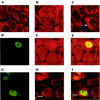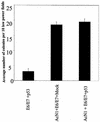Activated Notch1 inhibits p53-induced apoptosis and sustains transformation by human papillomavirus type 16 E6 and E7 oncogenes through a PI3K-PKB/Akt-dependent pathway
- PMID: 12768030
- PMCID: PMC156194
- DOI: 10.1128/jvi.77.12.7106-7112.2003
Activated Notch1 inhibits p53-induced apoptosis and sustains transformation by human papillomavirus type 16 E6 and E7 oncogenes through a PI3K-PKB/Akt-dependent pathway
Abstract
Activated Notch1 (AcN1) alleles cooperate with oncogenes from DNA tumor viruses in transformation of epithelial cells. AcN1 signaling has pleiotropic effects, and suggested oncogenic roles include driving proliferation through cyclin D1 or the generation of resistance to apoptosis on matrix withdrawal through a phosphatidylinositol 3-kinase (PI3K)-PKB/Akt-dependent pathway. Here, we extend the antiapoptotic role for AcN1 by showing inhibition of p53-induced apoptosis and transactivation. Chemical inhibitors of the PI3K pathway block AcN1-induced inhibition of p53-dependent apoptosis and nuclear localization of Hdm2. We show that expression of wild-type p53 does not inhibit synergistic transformation by AcN1 and human papillomavirus E6 and E7 oncogenes. We suggest that activation of Notch signaling may serve as an additional mechanism to inhibit wild-type p53 function in papillomavirus-associated neoplasia.
Figures






Similar articles
-
Activated Notch1 signaling cooperates with papillomavirus oncogenes in transformation and generates resistance to apoptosis on matrix withdrawal through PKB/Akt.Virology. 2001 Jul 20;286(1):23-30. doi: 10.1006/viro.2001.0867. Virology. 2001. PMID: 11448155
-
Repression of human papillomavirus oncogenes in HeLa cervical carcinoma cells causes the orderly reactivation of dormant tumor suppressor pathways.Proc Natl Acad Sci U S A. 2000 Nov 7;97(23):12513-8. doi: 10.1073/pnas.97.23.12513. Proc Natl Acad Sci U S A. 2000. PMID: 11070078 Free PMC article.
-
The anti-apoptotic effect of Notch-1 requires p56lck-dependent, Akt/PKB-mediated signaling in T cells.J Biol Chem. 2004 Jan 23;279(4):2937-44. doi: 10.1074/jbc.M309924200. Epub 2003 Oct 28. J Biol Chem. 2004. PMID: 14583609
-
The role of the PI3K/Akt/mTOR signalling pathway in human cancers induced by infection with human papillomaviruses.Mol Cancer. 2015 Apr 17;14:87. doi: 10.1186/s12943-015-0361-x. Mol Cancer. 2015. PMID: 26022660 Free PMC article. Review.
-
Signaling pathways in apoptosis as potential targets for cancer therapy.Trends Cell Biol. 2001 Aug;11(8):343-8. doi: 10.1016/s0962-8924(01)02063-3. Trends Cell Biol. 2001. PMID: 11489640 Review.
Cited by
-
Analysis of Notch and TGF-β Signaling Expression in Different Stages of Disease Progression During Hepatitis B Virus Infection.Clin Transl Gastroenterol. 2012 Oct 4;3(10):e23. doi: 10.1038/ctg.2012.17. Clin Transl Gastroenterol. 2012. PMID: 23238065 Free PMC article.
-
Correlation of Notch1, pAKT and nuclear NF-κB expression in triple negative breast cancer.Am J Cancer Res. 2013 Apr 3;3(2):230-9. Print 2013. Am J Cancer Res. 2013. PMID: 23593544 Free PMC article.
-
Redifferentiation of expanded human pancreatic β-cell-derived cells by inhibition of the NOTCH pathway.J Biol Chem. 2012 May 18;287(21):17269-17280. doi: 10.1074/jbc.M111.319152. Epub 2012 Mar 28. J Biol Chem. 2012. PMID: 22457355 Free PMC article.
-
Phosphorylation of PI3K/Akt and MAPK/ERK in an early entry step of enterovirus 71.Life Sci. 2005 Nov 19;78(1):82-90. doi: 10.1016/j.lfs.2005.04.076. Epub 2005 Sep 8. Life Sci. 2005. PMID: 16150462 Free PMC article.
-
The FoxO3a gene is a key negative target of canonical Notch signalling in the keratinocyte UVB response.EMBO J. 2008 Apr 23;27(8):1243-54. doi: 10.1038/emboj.2008.45. Epub 2008 Apr 3. EMBO J. 2008. PMID: 18388864 Free PMC article.
References
-
- Ashcroft, M., R. L. Ludwig, D. B. Woods, T. D. Copeland, H. O. Weber, E. J. MacRae, and K. H. Vousden. 2002. Phosphorylation of HDM2 by Akt. Oncogene 21:1955-1962. - PubMed
-
- Aster, J. C., and W. S. Pear. 2001. Notch signaling in leukemia. Curr. Opin. Hematol. 8:237-244. - PubMed
-
- Brazil, D. P., and B. A. Hemmings. 2001. Ten years of protein kinase B signalling: a hard Akt to follow. Trends Biochem. Sci. 26:657-664. - PubMed
-
- Daniel, B., A. Rangarajan, G. Mukherjee, E. Vallikad, and S. Krishna. 1997. The link between integration and expression of human papillomavirus type 16 genomes and cellular changes in the evolution of cervical intraepithelial neoplastic lesions. J. Gen. Virol. 78:1095-1101. - PubMed
Publication types
MeSH terms
Substances
LinkOut - more resources
Full Text Sources
Other Literature Sources
Research Materials
Miscellaneous

